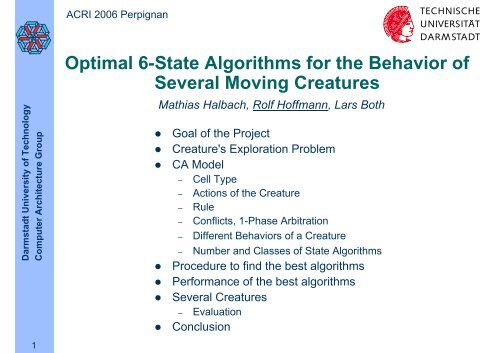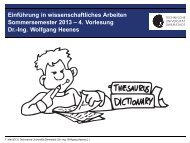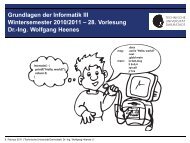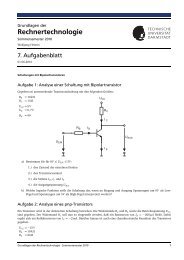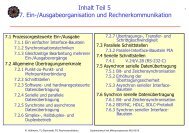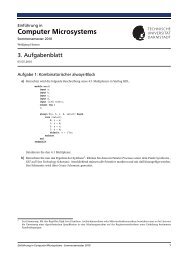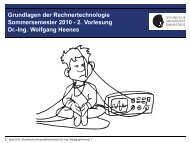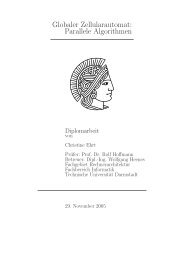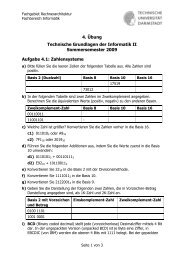State Algorithm - Ra.informatik.tu-darmstadt.de
State Algorithm - Ra.informatik.tu-darmstadt.de
State Algorithm - Ra.informatik.tu-darmstadt.de
Create successful ePaper yourself
Turn your PDF publications into a flip-book with our unique Google optimized e-Paper software.
ACRI 2006 Perpignan<br />
Optimal 6-<strong>State</strong> <strong>Algorithm</strong>s for the Behavior of<br />
Several Moving Crea<strong>tu</strong>res<br />
Darmstadt University of Technology<br />
Computer Architec<strong>tu</strong>re Group<br />
Mathias Halbach, Rolf Hoffmann, Lars Both<br />
• Goal of the Project<br />
• Crea<strong>tu</strong>re's Exploration Problem<br />
• CA Mo<strong>de</strong>l<br />
– Cell Type<br />
– Actions of the Crea<strong>tu</strong>re<br />
– Rule<br />
– Conflicts, 1-Phase Arbitration<br />
– Different Behaviors of a Crea<strong>tu</strong>re<br />
– Number and Classes of <strong>State</strong> <strong>Algorithm</strong>s<br />
• Procedure to find the best algorithms<br />
• Performance of the best algorithms<br />
• Several Crea<strong>tu</strong>res<br />
– Evaluation<br />
• Conclusion<br />
1
Goal of the Project in general<br />
Darmstadt University of Technology<br />
Computer Architec<strong>tu</strong>re Group<br />
• Challenge<br />
– Automatically <strong>de</strong>tecting optimal rules for given CA problems, in<br />
particular problems with moving crea<strong>tu</strong>res/agents/robots<br />
– Why: <strong>State</strong> Explosion, Very time consuming<br />
• Solution<br />
– Find efficient algorithms for<br />
• selection of relevant rules<br />
• simulation<br />
• evaluation<br />
– Hardware Support<br />
• Applications<br />
– Artificial Worlds<br />
– Mo<strong>de</strong>ls of Real Worlds<br />
– Computational Tasks<br />
2
Crea<strong>tu</strong>re's Exploration Problem<br />
Darmstadt University of Technology<br />
Computer Architec<strong>tu</strong>re Group<br />
• The Problem<br />
– Given is a 2D-CA with obstacles and<br />
moving crea<strong>tu</strong>res.<br />
– Goal:<br />
Find an optimal local rule for the<br />
crea<strong>tu</strong>res to visit a maximum<br />
number of empty cells with a<br />
minimum number of time steps for a<br />
given set of initial configurations.<br />
• Applications<br />
– Mowing a lawn in shortest time<br />
– Vacuum cleaning a room by a robot<br />
– Exploring an unknown environment<br />
3
The Actions of the Crea<strong>tu</strong>res<br />
Darmstadt University of Technology<br />
Computer Architec<strong>tu</strong>re Group<br />
L<br />
R<br />
Lm<br />
Rm<br />
(<strong>tu</strong>rn Left)<br />
(<strong>tu</strong>rn Right)<br />
(<strong>tu</strong>rn Left and move)<br />
move forward and<br />
simultaneously <strong>tu</strong>rn left<br />
(<strong>tu</strong>rn Right and move)<br />
move forward and<br />
simultaneously <strong>tu</strong>rn right<br />
4
The Rule for the Crea<strong>tu</strong>res<br />
FrontCell<br />
Legend<br />
Darmstadt University of Technology<br />
Computer Architec<strong>tu</strong>re Group<br />
(a1) if (obstacle or crea<strong>tu</strong>re) then<br />
(a2) if (collision) then<br />
<strong>tu</strong>rn (L/R)<br />
<strong>tu</strong>rn (L/R)<br />
obstacle or<br />
crea<strong>tu</strong>re<br />
irrelevant<br />
5<br />
(b) if not((a1) or (a2)) then <strong>tu</strong>rn and move(Lm/Rm)<br />
crea<strong>tu</strong>re<br />
in one<br />
out of two<br />
directions
CA: Cell Type<br />
Darmstadt University of Technology<br />
Computer Architec<strong>tu</strong>re Group<br />
Type<br />
CREATURE<br />
EMPTY<br />
Direction r<br />
toNorth, toEast,<br />
toSouth, toWest<br />
(irrelevant)<br />
control state s<br />
0, 1, ... (N-1)<br />
OBSTACLE<br />
(irrelevant)<br />
6
CA: Rule<br />
Darmstadt University of Technology<br />
Computer Architec<strong>tu</strong>re Group<br />
Rule for My.Type = CREATURE<br />
(a1) {CASE free}<br />
if (My.FrontCell.Type = EMPTY) and (My.FrontCell.SignalsFree) then<br />
• My.Type := EMPTY // <strong>de</strong>lete, because of moving<br />
else<br />
(b) {CASE not free}<br />
• My.Direction:= TurnRight/Left (My.Direction) // only <strong>tu</strong>rn R, L<br />
Rule for My.Type = EMPTY<br />
(a2) {CASE free}<br />
n = Number of crea<strong>tu</strong>res with direction to MY<br />
if (n=1) then<br />
• My.Type := CREATURE // create (move by copy)<br />
• My.Direction := TurnRight/Left (My.NeighborCrea<strong>tu</strong>re.Direction) // new direction<br />
Coupled Action<br />
In case a1 and a2 where a crea<strong>tu</strong>re can move, it changes its own type<br />
to EMPTY (case a1) and at the same time the empty cell changes its<br />
type to CREATURE (case a2).<br />
7<br />
In case b where the cell cannot move, it will <strong>tu</strong>rn only right or left.
Conflict Resolution<br />
cell in conflict<br />
(front cell)<br />
Darmstadt University of Technology<br />
Computer Architec<strong>tu</strong>re Group<br />
• More than one crea<strong>tu</strong>re wants to move to the same cell<br />
• Result of conflict resolution in general<br />
– either no crea<strong>tu</strong>re can move, or<br />
– one crea<strong>tu</strong>re is selected to move<br />
• Implementations<br />
– 2-phase arbitration<br />
(1) check for conflict and select one crea<strong>tu</strong>re<br />
(2) the selected crea<strong>tu</strong>re will move<br />
– 1-phase arbitration (our solution, see next sli<strong>de</strong>)<br />
8
1-Phase Arbitration<br />
Darmstadt University of Technology<br />
Computer Architec<strong>tu</strong>re Group<br />
request i<br />
grant i<br />
front<br />
cell<br />
feed-back<br />
logic<br />
• front cell contains a feed-back logic for the arbitration<br />
• evaluates the number Q of requests<br />
• if (Q>1) then grant = 0 else grant = 1<br />
• grant is computed within the current clock cycle<br />
9
Different Behaviors of a Crea<strong>tu</strong>re<br />
• Mo<strong>de</strong>led by a changdable Control Machine and a fixed Output-Machine<br />
• Control Machine implements <strong>State</strong> <strong>Algorithm</strong><br />
Darmstadt University of Technology<br />
Computer Architec<strong>tu</strong>re Group<br />
grant signal from neighbor in front (front cell)<br />
m<br />
0 0<br />
0 1<br />
0 2<br />
0 3<br />
0 4<br />
0 5<br />
1 0<br />
1 1<br />
1 2<br />
1 3<br />
1 4<br />
1 5<br />
1 L<br />
2 L<br />
0 L<br />
4 R<br />
5 R<br />
3 R<br />
3 Lm<br />
1 Rm<br />
5 Lm<br />
0 Rm<br />
4 Lm<br />
2 Rm<br />
s'<br />
d<br />
s<br />
v<br />
r<br />
s control state<br />
r direction<br />
d action<br />
v(r,d) new direction<br />
m crea<strong>tu</strong>re can move<br />
L/R <strong>tu</strong>rn left/R if (m=1)<br />
Lm/Rm <strong>tu</strong>rn left/R and move if (m=0)<br />
if d=1 then<br />
r:=r+1 (<strong>tu</strong>rn right)<br />
else<br />
r:=r-1 (<strong>tu</strong>rn left)<br />
10<br />
MEALY-<br />
Control-Machine<br />
MOORE-<br />
Output-Machine
Representation of a <strong>State</strong> <strong>Algorithm</strong><br />
• state/output-table state/output-graph<br />
m<br />
6-state algorithm<br />
Darmstadt University of Technology<br />
Computer Architec<strong>tu</strong>re Group<br />
11<br />
0 0<br />
0 1<br />
0 2<br />
0 3<br />
0 4<br />
0 5<br />
1 0<br />
1 1<br />
1 2<br />
1 3<br />
1 4<br />
1 5<br />
1 L<br />
2 L<br />
0 L<br />
4 R<br />
5 R<br />
3 R<br />
3 Lm<br />
1 Rm<br />
5 Lm<br />
0 Rm<br />
4 Lm<br />
2 Rm<br />
s<br />
action<br />
d<br />
• string repesentation<br />
0 2<br />
blocked, m=0<br />
move, m=1<br />
1L2L0L4R5R3R-3Lm1Rm5Lm0Rm4Lm2Rm<br />
= 1L2L0L4R5R3R-3L1R5L0R4L2R simplified<br />
L<br />
1<br />
3 5<br />
4<br />
Rm<br />
Rm Lm Rm Lm<br />
R<br />
R<br />
Lm<br />
R<br />
L
Number of <strong>State</strong> <strong>Algorithm</strong>s<br />
Darmstadt University of Technology<br />
Computer Architec<strong>tu</strong>re Group<br />
• M = Number of all control algorithms (Mealy state<br />
machines), represented by a state table<br />
– #s: number of states<br />
– #x: number of input values (blocked or free e.g. 2)<br />
– #y: number of actions (<strong>tu</strong>rn left or right e.g. 2)<br />
• M = (#s #y) (#s #x) (2#s) (2#s)<br />
12
Classes of <strong>State</strong> <strong>Algorithm</strong>s<br />
Darmstadt University of Technology<br />
Computer Architec<strong>tu</strong>re Group<br />
• P (without prefix)<br />
– Each state reachable from initial state 0 is able to re<strong>tu</strong>rn to the initial state.<br />
• N (normalized)<br />
– Equivalent algorithms which only differ in their state encodings are represented<br />
in a unique form. Only the representatives are in this class.<br />
• R (irreducible)<br />
– <strong>Algorithm</strong>s in this class are true n-state algorithms which cannot be reduced to<br />
algorithms with less than n states.<br />
• V (all reachable)<br />
– All states can be reached from the initial state 0 for each algorithm in this class.<br />
• Relevant <strong>Algorithm</strong>s<br />
– Q = P ∩ N ∩ V ∩ R<br />
13
Darmstadt University of Technology<br />
Computer Architec<strong>tu</strong>re Group<br />
14<br />
N<br />
3 states, 2 inputs, 2 outputs<br />
R<br />
12 36 99 49<br />
1124 3228 8124 1348<br />
1124 3228 8124 1348<br />
1260 2148 10653 4751<br />
P<br />
all algorithms M = 46 656<br />
V
Relevant algorithms for #x = #y = 2<br />
states<br />
All algorithms<br />
Relevant<br />
#s<br />
M<br />
<strong>Algorithm</strong>s<br />
Darmstadt University of Technology<br />
Computer Architec<strong>tu</strong>re Group<br />
2<br />
3<br />
4<br />
5<br />
6<br />
4 4 = 256<br />
6 6 = 46 656<br />
8 8 = 16 777 216<br />
10 10 = 10 * 10 9<br />
12 12 = 8.92 * 10 12<br />
108<br />
[42.2 %]<br />
8 124<br />
[17.4 %]<br />
798 384<br />
[4.8 %]<br />
98 869 740<br />
[1 %]<br />
14 762 149 668<br />
[0.2 %]<br />
15
Procedure to find the best algorithms<br />
generate next algorithm (state table)<br />
Darmstadt University of Technology<br />
Computer Architec<strong>tu</strong>re Group<br />
∀ algorithms<br />
discard irrelevant algorithms<br />
∀ initial configurations: simulate and evaluate behavior<br />
discard alg. with poor performance<br />
store set of candidates with good performance<br />
<strong>de</strong>tailed evalutation and statistics<br />
i<strong>de</strong>ntify best algorithms<br />
test for robustness with further initital configurations<br />
FPGA Hardware<br />
Software<br />
16<br />
testing the performance with more than one crea<strong>tu</strong>re
5 Initial Configurations: The First Test Set<br />
1 2 3 4 5<br />
Darmstadt University of Technology<br />
Computer Architec<strong>tu</strong>re Group<br />
17
Further 21 initial configurations for robustness test<br />
Darmstadt University of Technology<br />
Computer Architec<strong>tu</strong>re Group<br />
• Robustness : crea<strong>tu</strong>re behaves also well un<strong>de</strong>r other<br />
conditions (initial cofigurations)<br />
Samples<br />
Config. 16<br />
Config. 15<br />
18
Performance of the best algorithms<br />
successful<br />
(100 % crossed)<br />
unsuccessful<br />
Darmstadt University of Technology<br />
Computer Architec<strong>tu</strong>re Group<br />
AL<br />
GO<br />
RIT<br />
HM<br />
A6<br />
B6<br />
C6<br />
D6<br />
E6<br />
F6<br />
1<br />
2<br />
3<br />
4<br />
5<br />
26 Configuration (Test set)<br />
6 7 8 9 1 1 1 1 1 1 1 1 1 1 2 2<br />
0 1 2 3 4 5 6 7 8 9 0 1<br />
2<br />
2<br />
2<br />
3<br />
2<br />
4<br />
2<br />
5<br />
2<br />
6<br />
Success<br />
23<br />
24<br />
23<br />
22<br />
24<br />
24<br />
Crossing<br />
Perform.<br />
99.07<br />
99.92<br />
99.29<br />
98.63<br />
99.12<br />
97.94<br />
Speed<br />
.136<br />
.252<br />
.259<br />
.251<br />
.223<br />
.238<br />
G6<br />
24<br />
99.92<br />
.260<br />
x<br />
H6<br />
21<br />
98.91<br />
.169<br />
I6<br />
21<br />
98.91<br />
.193<br />
J6<br />
16<br />
78.55<br />
.299<br />
K6<br />
23<br />
99.87<br />
.268<br />
19
The two best 6-<strong>State</strong>-<strong>Algorithm</strong>s<br />
Rm<br />
Lm<br />
Darmstadt University of Technology<br />
Computer Architec<strong>tu</strong>re Group<br />
Rm<br />
1<br />
L<br />
L<br />
R interchanged with L<br />
1<br />
R<br />
R<br />
0 2<br />
0 2<br />
L<br />
R<br />
Rm<br />
Lm<br />
Lm<br />
Lm<br />
Lm<br />
Rm<br />
R<br />
L<br />
3 5<br />
3 5<br />
R<br />
4<br />
R<br />
L<br />
4<br />
L<br />
Rm<br />
Lm<br />
Rm<br />
20<br />
<strong>Algorithm</strong> G6<br />
behaves slighty better for the 26 configs.<br />
<strong>Algorithm</strong> B6
Speed of 6-<strong>State</strong> <strong>Algorithm</strong>s for Config. 15<br />
Darmstadt University of Technology<br />
Computer Architec<strong>tu</strong>re Group<br />
J6<br />
B6<br />
G6<br />
D6<br />
B6: 2599<br />
G6: 2592<br />
Speed <strong>de</strong>pends on algorithm<br />
and configuration<br />
Alg.<br />
A6<br />
B6<br />
C6<br />
D6<br />
E6<br />
F6<br />
G6<br />
1/speed<br />
5.9<br />
4.9<br />
5.9<br />
3.7<br />
6.4<br />
6.4<br />
4.9<br />
speed<br />
.168<br />
.205<br />
.170<br />
.271<br />
.157<br />
.156<br />
.205<br />
H6<br />
6.9<br />
.144<br />
I6<br />
6.1<br />
.162<br />
J6<br />
(2.3)<br />
(.433)<br />
J6 fast at the beginning<br />
but is not succesful<br />
21
Darmstadt University of Technology<br />
Computer Architec<strong>tu</strong>re Group<br />
22<br />
Config. 7, Alg. B6<br />
first cyclic path<br />
2 cells can not be reached<br />
second cyclic path
Several Crea<strong>tu</strong>res<br />
Initial configurations used to evaluate the behavior of several crea<strong>tu</strong>res<br />
Darmstadt University of Technology<br />
Computer Architec<strong>tu</strong>re Group<br />
1 2 4 8 16<br />
23
Darmstadt University of Technology<br />
Computer Architec<strong>tu</strong>re Group<br />
24<br />
Generations and Speed using n Crea<strong>tu</strong>res<br />
Generations to visit all empty cells with n crea<strong>tu</strong>res<br />
33 times faster<br />
(with 16 crea<strong>tu</strong>res)
Generations and Speed using n Crea<strong>tu</strong>res<br />
Definition:<br />
Speed = empty cells / generations<br />
Darmstadt University of Technology<br />
Computer Architec<strong>tu</strong>re Group<br />
Speed per crea<strong>tu</strong>re = Speed / n<br />
Four crea<strong>tu</strong>res with algorithm A6 work relatively faster<br />
than one crea<strong>tu</strong>re with the best algorithm J6<br />
(0.52 0.53)<br />
25
Conclusion<br />
Darmstadt University of Technology<br />
Computer Architec<strong>tu</strong>re Group<br />
• Crea<strong>tu</strong>re's Exploration<br />
Problem was mo<strong>de</strong>led by CA<br />
• Conflicts are solved using a<br />
new 1-phase arbitration logic<br />
• Behavior of a crea<strong>tu</strong>re is<br />
mo<strong>de</strong>led by a Mealy-Control-<br />
Machine and an Output-<br />
Machine<br />
• <strong>State</strong> <strong>Algorithm</strong>s were or<strong>de</strong>red<br />
into classes.<br />
• Relevant algorithms<br />
– 6 states:<br />
14 762 149 668 [0,2 %]<br />
• Procedure to find best alg.<br />
1. hardware computes<br />
candidates<br />
2. software selects best alg. and<br />
tests for robustness<br />
3. software tests behavior of<br />
several crea<strong>tu</strong>res<br />
• Several crea<strong>tu</strong>res can perform<br />
the work more efficiently (in<br />
terms of speed per crea<strong>tu</strong>re)<br />
than only one.<br />
26
Hardware Platform<br />
Darmstadt University of Technology<br />
Computer Architec<strong>tu</strong>re Group<br />
• FPGA Altera Cyclone<br />
EP1C20F324C7<br />
• Altera Quar<strong>tu</strong>s II Tools<br />
– VERILOG FPGA-Logic<br />
• USB Module<br />
– connected to a PC<br />
– for control and data<br />
communication<br />
• Computation in Hardware<br />
– algorithm search, simulation and<br />
evaluation (5 configs in parallel)<br />
– Hardware/Software Speed-Up:<br />
100 to 10 000 <strong>de</strong>pending on<br />
FPGA<br />
27


